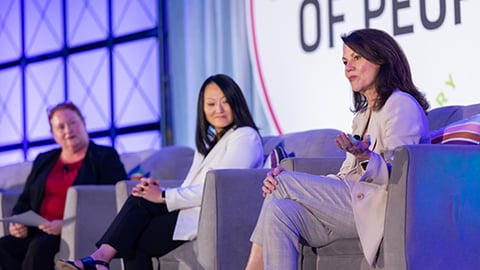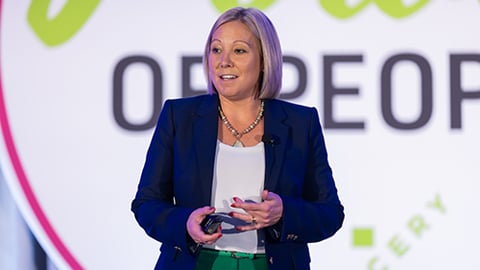How Marketers are Tackling an Increasingly Fragmented Environment
If meeting consumers where they are on the shopping journey has become an oft-repeated mantra over the past few years, it’s with good reason: There’s no one way to shop anymore, either in store or online, and retailers, brands and solution provider partners must heed those behaviors to advance their businesses.
RELATED: Lowes Foods CEO Wants Grocers to Believe in Magic
That split path to the final dollar destination was the focus of the Path to Purchase Institute’s recent P2PI Live & Expo event, held Nov. 12-14 in Schaumburg, Ill., near Chicago. Members of the commerce marketing community met to connect and gain insights through a full slate of educational sessions.
Progressive Grocer, a sister brand of the Path to Purchase Institute, was on hand for some of those presentations. Below are a few takeaways from this year’s event:
Price still shapes POV: Leading up to and following a national election cycle with grocery prices at the heart of the discourse, speakers at P2PI Live & Expo reported that shoppers remain hyper-aware of affordability. During a keynote session on trends in consumer behavior, two experts from The Harris Poll affirmed that inflation should still be a focus of marketing programs. “Many Americans are struggling financially. About a third say they are just getting by, and 75% say they are prioritizing their inflation because of inflation. Eighty-eight percent of Americans agree that gas, groceries and housing costs are the things that really matter and hit them at home,” said VP Michele Salomon.
She and her co-presenter, Research Director Gabriel Rozenwasser, shared several data points showing that despite indicators that the economy is improving, consumers are feeling the pinch. “While the economists and experts may say things are getting better, people really are not feeling that at their kitchen table,” Salomon asserted. The Harris Poll surveys also show that shoppers by and large want their preferred brands to “stay out of” politics.
In-store shopping remains a mostly enjoyable experience. In the keynote, Salomon confirmed that consumers like to go to brick-and-mortar stores. “People preferred to a greater or lesser degree in-store shopping because they can discover new products. It's not being dictated by an algorithm, for example. They can see what's actually available,” she said, adding, “But we are searching for a better retail experience. We're looking for more immersive experiences. We want something that's going to activate more or all of our touch, sight, smell -- all of the things. And very importantly, younger consumers want to be fully immersed in your brand the minute they walk into your store.”
Retail media networks are an increasingly important guidepost in the path: During a breakout session on driving brand growth through unified retail media networks (RMNs), a trio of professionals emphasized the ways that RMNs are instrumental in the shopper journey. “In-store is the moment of truth for an omnichannel campaign,” pointed out Michael Halverson, principal product manager at Albertsons Media Collective. Lindsey Susick, director, client development at Walgreens Advertising Group, agreed, citing the company’s new digital in-store campaign. “It's in a few select stores right now, but we are really keen on getting that stood up across our marketplace and making sure we have the right measurement to prove our success is working there, and now we're actually driving sales,” she observed.
Also during that discussion, Mark Williamson, AVP at Costco Wholesale Corp., noted that having an omnichannel mindset is top of mind at the club store chain and at other retailers, because decisions are made in multiple channels, and experiences should be linked together as much as possible. “What we think about is what makes sense for the unique physical environment of every retailer. It could be, ‘What does the traffic flow look like? What's the assortment? What's the layout, what's the space? Is the ceiling high, the ceiling low?’ All these sorts of things have to come into play,” he remarked. “And so, I think for retail media shifts into an omnichannel space, it's not just about the capabilities that are able to be unlocked, but what feels endemic to the shopping experience in store.”
Effective loyalty programs zero in on shoppers, but don’t overwhelm them. A panel focusing on how to unify consumer value delivery in loyalty programs underscored the ways that non-siloed loyalty programs can target, rather than bombard, users. “That’s the concern – that all of a sudden, you’re just going to get ambushed by the brand. But the opportunity for consolidation actually reduces the volume of communications that you're going to have with hyper-personalization – you synchronize these efforts and your volume of communication can actually decrease,” explained Chris Galloway, EVP, loyalty program strategy and design with shopper loyalty and promotion solution provider Brandmovers, adding, “The opportunity is to turn down the volume, but to turn up the amplitude.”
Disruptors and challengers can find a receptive shopper audience. Grocers and their CPG partners can satisfy shoppers’ penchant for discovery with nontraditional products, according to marketers featured in a session on challenger brands in new categories. The session participants underscored the importance of conveying authenticity as much as innovation. “Simply stated, I believe in an advocacy-based marketing model that has a social-centricity to it, focused on the most influential and powerful cohorts that can promote your brand,” said Andy Judd, CMO at prebiotic beverage brand poppi.
Echoed Andrew Katz, CMO at non-alcoholic brewery Athletic Brewing Co.: “We start the proposition with what we aren't, and we try to do as much experiential marketing as possible – cans in hands, getting people to try the product. When I think about how we're thinking about our marketing mix, a lot of it is both top of funnel in terms of we're really trying to stand for something. Also, at the bottom of the funnel, we are very digitally oriented. The mix that we're using, what we're looking always at is, ‘What is the long-term value of what we're doing? What is the shorter-term value?’ And we're just trying to consistently find that fine balance between the two.”







